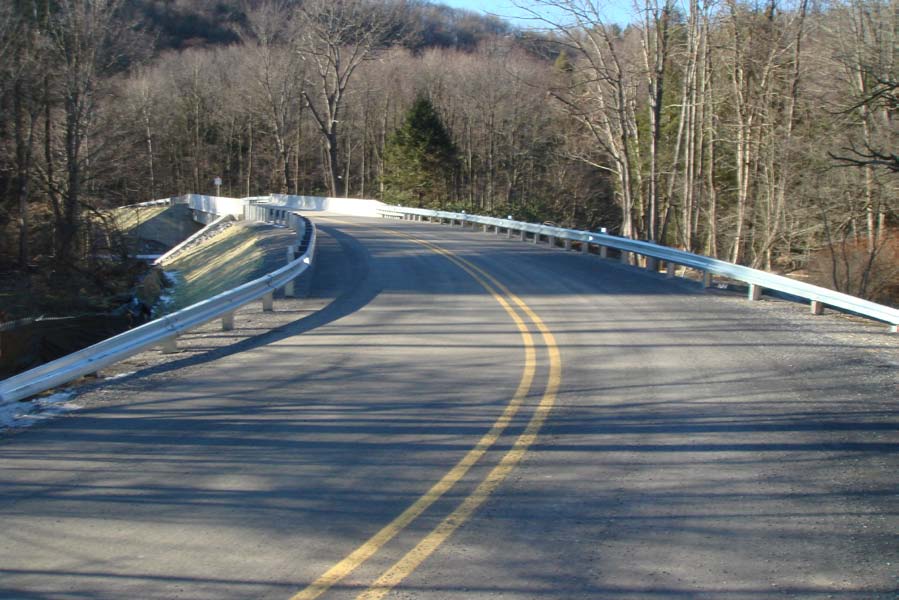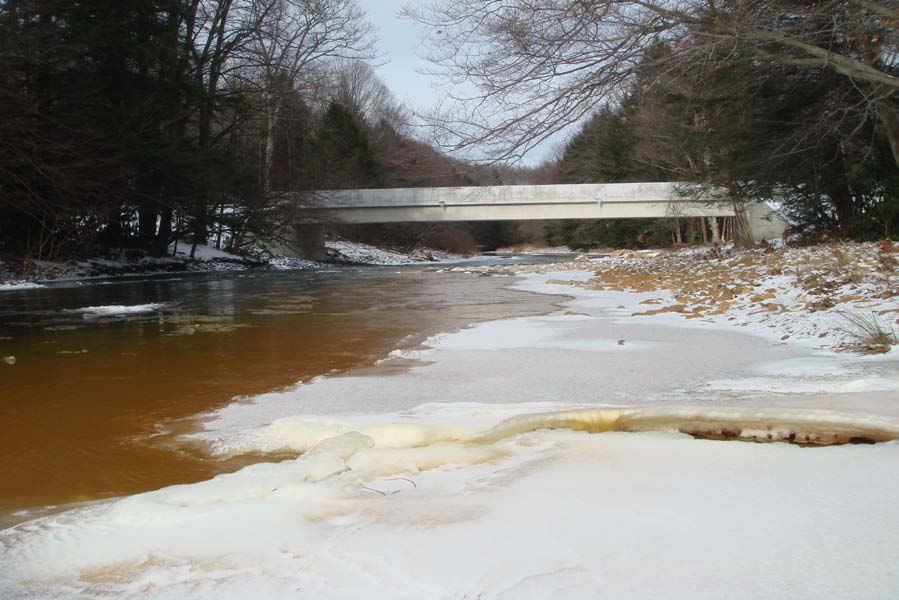We Recommend:
Bach Steel - Experts at historic truss bridge restoration.
BridgeHunter.com Phase 1 is released to the public! - Visit Now
Dean Bridge
Kolak Road Bridge

Primary Photographer(s): Nathan Holth and Rick McOmber
Bridge Documented: June 1, 2010
Dean: Cambria County, Pennsylvania: United States
1902 By Builder/Contractor: King Bridge Company of Cleveland, Ohio
Not Available or Not Applicable
102.0 Feet (31.1 Meters)
104.0 Feet (31.7 Meters)
12.8 Feet (3.9 Meters)
1 Main Span(s)
11720705123011

View Information About HSR Ratings
Bridge Documentation
This bridge no longer exists!
View Archived National Bridge Inventory Report - Has Additional Details and Evaluation
This historic bridge was demolished in 2010!
This beautiful historic truss bridge which so perfectly complimented its scenic river with its bright orangeish/red rocks and mud is only the latest truss bridge to be demolished in Pennsylvania. The bridge was a good example of work by the King Bridge Company, an important and prolific bridge company. The company installed its decorative portal knee braces on this bridge, enhancing the bridge's attractive appearance.
The seven panel truss is configured as follows: Endposts: and top chord: back-to-back channels with battens and cover plate, bottom chord: up-set eyebars, diagonal members: up-set eyebars, vertical members: back-to-back channels with v-lacing on each side, struts: two pairs of riveted angles with v-lacing between, portal bracing: two pairs of riveted angles with lattice mesh and decorative curved knee bracing, floorbeams: rolled American Standard Beams, railing: two angles with v-lacing, deck: traditional wood deck on metal deck stringers.
The bridge was altered with additional diagonal members as well as random welded repairs on some eyebars and bracing. Some of the alterations on the bridge are reversible and some are not. Discounting the reversible alterations, this bridge should not be considered heavily altered. It most certainly could be relocated and restored for pedestrian traffic, or alternatively rehabilitated in place for continued light vehicular traffic.
Preservation success stories of bridges such as the Dean Bridge can be found in surrounding states like Maryland, New Jersey, New York, and further away as Michigan, Indiana, and Texas. However, preservation of metal truss bridges in Pennsylvania is relatively non-existent in comparison, despite the fact that Pennsylvania has (or had) one of the largest and most diverse, and oldest collection of metal truss bridges in the country. As the traditional home of the iron and steel industry, one would think that Pennsylvania would be the leader in preserving this key part of their heritage. Instead, they trail far behind. The time for change is now. It is not quite too late for PennDOT and other involved Pennsylvania agencies to have a change of heart. HistoricBridges.org is always willing to advise and assist these agencies to help them find ways to develop cost-effective and high quality preservation projects.
Any change of heart in Pennsylvania's attitude toward historic truss bridges did not come soon enough for this bridge. Despite a wide range of potential preservation alternatives, this beautiful bridge was sentenced to the dumpster, with plans to construct a replacement bridge that will have no heritage and will be ugly in appearance. Bridge construction used to be similar to building construction in that architecture, and aesthetics were involved in the process. Today however, bridges do not have such design. They are little more than slabs of concrete, no more noteworthy than the appearance of the roadway surface leading up to them. Need proof? Look no further than the three images of this bridge's replacement, shown below. There is perhaps no greater argument in favor of preservation than the shear ugliness of the bridges that replace these historic truss bridges.
   |
| Above: Photos of the replacement structure. Photo Credit: PennDOT |
Comments on National Register Eligibility
The Pennsylvania Historic Bridge Inventory found this bridge, a 100+ year old pin-connected truss bridge, ineligible for the National Register! This is a ridiculous assessment. HistoricBridges.org believes that in the 21st Century, all surviving pin-connected truss bridges that retain the majority of their original material and design should be considered eligible. The rarity of them on today's roads demands no less. Further, the need to have these bridges considered eligible is even greater in Pennsylvania because of the rapid rate at which they are being demolished. Claims in the Historic Bridge Inventory that there are tons of older and better historic bridges are extremely outdated. There has been a massacre of pin-connected truss bridges in Pennsylvania since the Historic Bridge Inventory was conducted. Many of those rarer and less altered bridges no longer exist. Because the stupid choice was made to demolish those better bridges, there is no choice now but to work with those examples that remain, even if they are later examples and more heavily altered.
This bridge has been altered, but regardless the majority of the original material and design is still there. Some might argue that considering a bridge like this eligible would diminish the significance of having a bridge considered eligible, and would diminish the recognition of the importance of those older and more intact bridges that are currently considered eligible. HistoricBridges.org understands that it is important to distinguish altered and later examples of pin-connected truss from earlier and less altered bridges. However the National Register's eligible/ineligible system is an all or nothing system, there is no "semi-historic" rating for example. To write a bridge like this one off as completely not historic, in other words "not eligible" is insane given the age of the bridge and the population of such bridges remaining. That being the case, there is no alternative but to consider the bridge eligible, and so eligible the bridge should be.
In particular with this bridge, it is worth noting that Pennsylvania went on a rampage to demolish two bridges built by the King Bridge Company in Clearfield County in a single construction season. One of these two bridges was one of the best examples of the King Bridge Company in the state. Even before this demolition, Pennsylvania only had a limited number of bridges built by the King Bridge Company. Because of this demolition, the rarity of bridges built by this prolific and important bridge builder has increased dramatically, and thus the significance of all surviving King bridges has increased greatly as well.
Information and Findings From Pennsylvania's Historic Bridge InventoryDiscussion of Bridge The pin connected, 104'-long, Pratt thru truss built in 1902 is supported on ashlar abutments with flared wingwalls. The traditionally composed bridge has built up top chords and verticals, and lower chords and diagonals of eye bars. The lower chord has been strengthened by post-tensioning. The bridge is a late example of its type and design, and it has no innovative or distinctive details. The bridge is the oldest of 5 pin connected truss bridges in the county. Earlier examples better represent the type and design. Neither this bridge nor its setting are historically or technologically significant. Discussion of Surrounding Area The bridge carries 1 lane of a road over a stream in a sparsely developed, rural area with scattered late 20th century residences near the village of Dean. The setting does not have historic district potential. Bridge Considered Historic By Survey: No |
![]()
Photo Galleries and Videos: Dean Bridge
Bridge Photo-Documentation
Original / Full Size PhotosA collection of overview and detail photos. This gallery offers photos in the highest available resolution and file size in a touch-friendly popup viewer.
Alternatively, Browse Without Using Viewer
![]()
Bridge Photo-Documentation
Mobile Optimized PhotosA collection of overview and detail photos. This gallery features data-friendly, fast-loading photos in a touch-friendly popup viewer.
Alternatively, Browse Without Using Viewer
![]()
Maps and Links: Dean Bridge
This historic bridge has been demolished. This map is shown for reference purposes only.
Coordinates (Latitude, Longitude):
Search For Additional Bridge Listings:
Bridgehunter.com: View listed bridges within 0.5 miles (0.8 kilometers) of this bridge.
Bridgehunter.com: View listed bridges within 10 miles (16 kilometers) of this bridge.
Additional Maps:
Google Streetview (If Available)
GeoHack (Additional Links and Coordinates)
Apple Maps (Via DuckDuckGo Search)
Apple Maps (Apple devices only)
Android: Open Location In Your Map or GPS App
Flickr Gallery (Find Nearby Photos)
Wikimedia Commons (Find Nearby Photos)
Directions Via Sygic For Android
Directions Via Sygic For iOS and Android Dolphin Browser
USGS National Map (United States Only)
Historical USGS Topo Maps (United States Only)
Historic Aerials (United States Only)
CalTopo Maps (United States Only)

